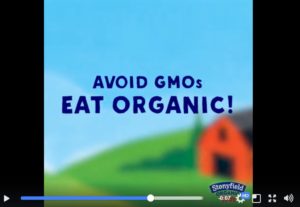Jan 29 2018
Shameless Organic Fearmongering
 I and others have long pointed out that anti-GMO fearmongering was largely created by the organic food lobby as a way of smearing their competitors. The strategy is simple – scare people way from genetically modified organisms (GMOs) and offer organic products as a non-GMO alternative. This is nothing new in advertising, create a fear and then offer your product as a safe haven.
I and others have long pointed out that anti-GMO fearmongering was largely created by the organic food lobby as a way of smearing their competitors. The strategy is simple – scare people way from genetically modified organisms (GMOs) and offer organic products as a non-GMO alternative. This is nothing new in advertising, create a fear and then offer your product as a safe haven.
A recent video posted by Stonyfield Organic makes the connection between anti-GMO fearmongering and buying organic explicit, as the screen capture shows.
There are many problems with this short video, not the least of which is that they use young girls to parrot their anti-science. Clearly not aiming for subtlety, the first girl declares that GMOs are “monstrous.” To apparently explain what she means, the second girl says that, “They take a gene from a fish and put it into a tomato.”
No, “they” don’t.
The “fishmato” has been a persistent myth of the anti-GMO lobby. It is both untrue, and unscientific even if it were true. The myth comes from the fact that in the 90’s there were experiments on putting a fish gene into a tomato in order to make it frost tolerant. The tomato was never marketed. In fact, at present there are no GMO tomatoes on the market.
But even if it were – so what? This is a perfect representation of the “frankenfood” strategy of the anti-GMO lobby. Fish and tomatoes, just like people and bananas, already share about 60% of our genes. There is nothing that makes a fish gene a fish gene, other than the fact that it is in a fish. They won’t make tomatoes have scales or taste fishy.
The reason the fishmato myth will not die, however, is because it is a useful way to manipulate people by triggering a vague sense of disgust.
This also represents the false dichotomy at the core of organic anti-GMO propaganda. In their narrative, food is divided into two clear groups. The first group is natural and wholesome. The second group – GMOs – are unnatural and scary. This division is a fiction.
In reality almost all food consumed by humans has been significantly modified using a range of methods. There is no clear dividing line between “GMO” and not “GMO”. If you want clear distinctions, you will have to delve deeper into specific methods.
Some equate GMOs with transgenic modification – inserting a gene from a distant species. However, that is just one form of genetic modification, and as I pointed out there is nothing inherently risky or unnatural about it. It even happens all the time in nature through horizontal gene transfer.
But there are a host of other methods, including forced hybridiation, mutation farming using radiation or chemicals that mutate seeds, and biotechnology that does not involve a transgene, such as using genes from related species, or just removing, silencing, or altering an existing gene.
In the organic anti-GMO narrative, however, there is a bright line in which mutation farming using radiation is natural and wholesome, and silencing a gene makes food “monstrous.”
An interesting wrinkle to the story of the Stonyfield video is that there was a significant backlash against the video in the comments. This is a good sign, showing that exposing the lies of the anti-GMO lobby is getting some traction.
Stonyfield responded by doubling down on their intellectual dishonesty – they deleted many of the critical comments claiming they were from “trolls.” Yet some of those deleted comments were from scientists with a publicly verifiable identity.
Dismissing (and deleting) critical comments as trolls is the equivalent of reflexively yelling, “Fake news” at any facts or opinions you don’t like.
They then tripled-down on their dubious behavior by claiming that they used an (undisclosed) database of fake names to locate the troll comments. Right.
In their open letter defending all this, Stonyfield digs themselves even deeper into anti-GMO propaganda. They explicitly equate GMOs with use of herbicides because that is what the current majoriy of GMO crops are for (herbicide tolerance). But this is irrelevant to the GMO debate, because GMOs (an arbitrary category) are essentially the result of a range of technologies, and cannot be equated to one specific application, even if it is currently the most common.
Further, they conveniently buy into anti-glyphosate fearmongering. Glyphosate is actually a relatively safe herbicide, with no credible link to cancer. This strategy also brings up the fact that organic farming can and often does use pesticides, as long as they are deemed “natural”, and many of them are far more toxic than glyphosate.
They then have the gall to call for labeling as if they are pro-transparency and people have the right to be informed, all the while misinforming the public about GMOs and organic farming.
They further link to anti-GMO propaganda sites as if they are credible or independent scientific sources. Meanwhile, actual scientific organizations have all come down on the side of the safety of GMOs.
This one little video is a microcosm of all the problems with using a false narrative and fearmongering in order to market pseudoscience, and how to exploit social media to forward that narrative and dismiss your critics.
At least Stonyfield was incompetent enough in their execution to make this strategy obvious. Hopefully in the end this will further expose the lies of the anti-GMO organic lobby.






